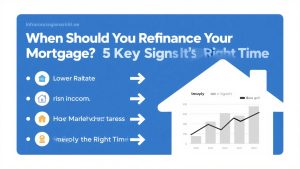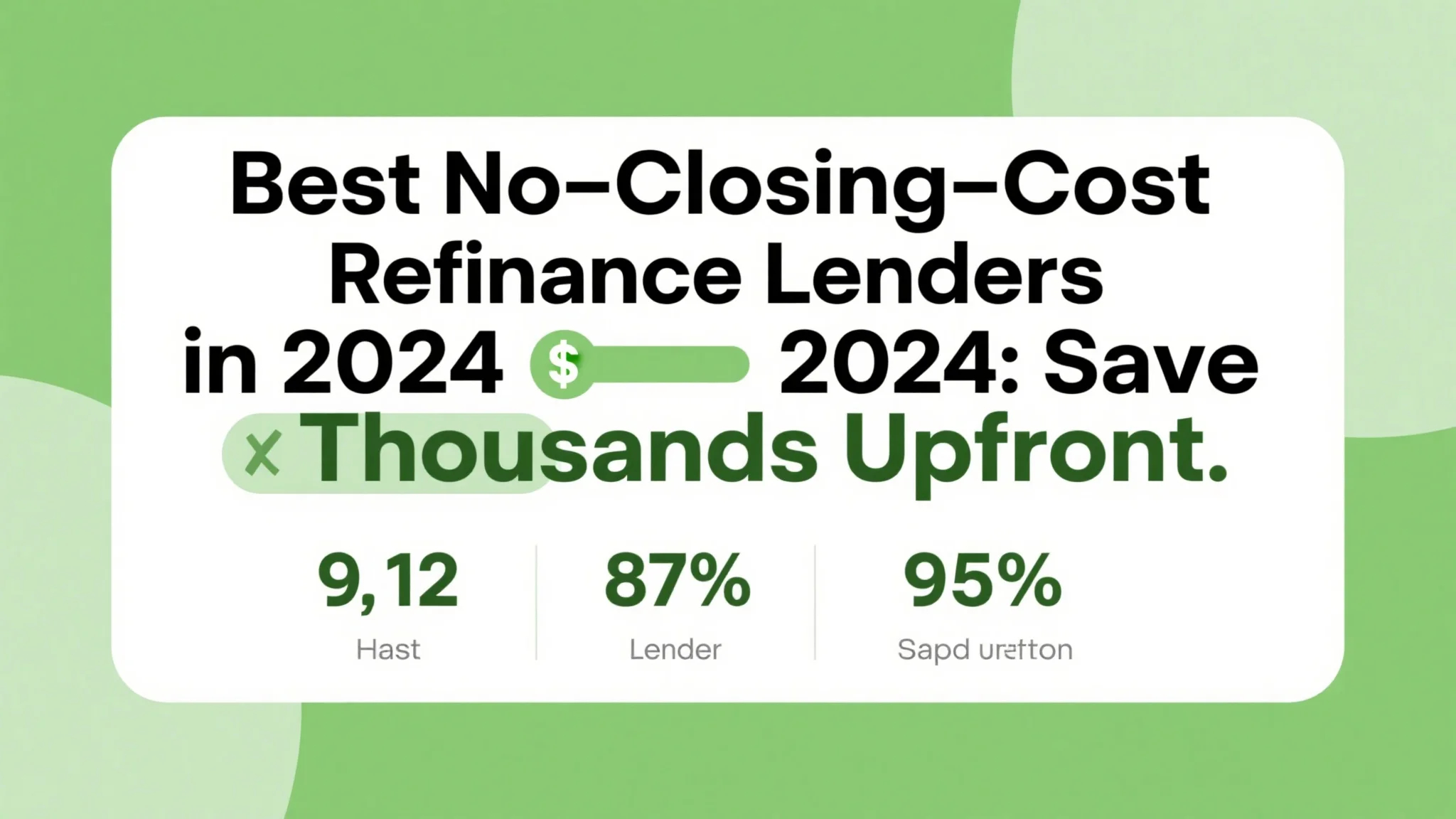Identifying the Optimal Time for Mortgage Refinancing
Determining the best time to refinance mortgage requires careful consideration of both personal financial circumstances and broader economic conditions. The most obvious signal emerges when current mortgage rate trends show a significant drop below your existing loan’s interest rate, typically at least 0.75% to 1% lower to justify the refinancing costs. However, rate differentials alone don’t tell the whole story – your planned duration in the home plays an equally crucial role. This is where utilizing a refinance break-even calculator becomes invaluable, helping you determine precisely how many months of reduced payments it will take to recoup your closing costs. The break-even point represents the minimum time you should plan to stay in the home after refinancing to realize genuine savings. Beyond pure financial calculations, life circumstances often provide the clearest indicators – major improvements in your credit score since obtaining the original loan, substantial increases in home equity, or changes in income that alter your debt-to-income ratio all create potentially advantageous refinancing conditions. Another often-overlooked factor involves the type of loan you currently hold – homeowners with adjustable-rate mortgages (ARMs) may find particular benefit in refinancing to fixed-rate loans when interest rates hit historic lows, locking in predictable payments for the loan’s duration. Similarly, those with FHA loans carrying mortgage insurance premiums (MIP) might discover that refinancing to a conventional loan could eliminate these ongoing costs if they’ve built sufficient equity. The decision becomes particularly compelling when multiple favorable factors converge – lower rates, improved credit, increased equity, and plans for long-term homeownership create a perfect storm for refinancing benefits. Seasonal patterns in the housing market can also influence timing – lenders often offer promotional rates during slower winter months, while spring and summer’s competitive markets may provide less flexibility on terms. Your personal cash flow situation represents another critical consideration – if you’re facing upcoming major expenses like college tuition or medical bills, securing lower mortgage payments beforehand can provide valuable financial breathing room. Military families anticipating permanent change of station (PCS) moves should carefully weigh refinancing timing against potential relocation timelines. Self-employed individuals or those with variable income might find refinancing advantageous during years of particularly high earnings that improve their qualifying income calculations. The emergence of new loan products or local housing programs can also create timely opportunities – some states offer special refinancing options for first responders, teachers, or military veterans that become available at specific times. Homeowners who initially purchased with minimal down payments should monitor their equity position – reaching 20% equity often triggers the ability to cancel private mortgage insurance (PMI) through refinancing. Those who’ve made significant home improvements increasing property value may find they’ve crossed this threshold sooner than anticipated. The tax implications of refinancing deserve careful analysis as well – while mortgage interest remains deductible, the Tax Cuts and Jobs Act of 2017 changed some parameters that might affect your specific situation. Consulting with a tax professional can help determine if refinancing in the current fiscal year provides advantages over waiting. For homeowners nearing retirement, refinancing to shorter-term loans (15 or 20 years instead of 30) while maintaining affordable payments can align mortgage payoff with retirement timelines. Conversely, younger homeowners might prioritize cash flow over term length, opting to restart the 30-year clock for maximum monthly savings they can redirect toward investments or other goals. The emotional component shouldn’t be underestimated either – the psychological benefit of reducing financial stress through lower payments can outweigh purely mathematical calculations for some homeowners. When multiple indicators align – favorable rate environment, strong credit position, sufficient equity, and plans for extended homeownership – they create an unmistakable signal that the time has come to seriously explore refinancing options.
Financial Metrics That Signal Refinancing Readiness
Beyond general timing considerations, specific financial metrics provide concrete evidence that you’ve reached the best time to refinance mortgage. The loan-to-value (LTV) ratio stands paramount among these – most lenders require 80% LTV or better for optimal refinancing terms, meaning you’ve built at least 20% equity in your home. Current mortgage rate trends must show rates at least 0.75% below your existing rate to generate meaningful savings, though this threshold varies based on loan size (larger loans may justify refinancing with smaller rate drops). Your credit score represents another crucial metric – improvements of 50 points or more since your original mortgage may qualify you for significantly better terms now. The debt-to-income (DTI) ratio similarly impacts refinancing decisions – if you’ve paid off other debts or increased your income, resulting in a lower DTI, lenders may offer more favorable refinancing options. Running these numbers through a refinance break-even calculator transforms them from abstract figures into actionable intelligence, clearly showing when savings outweigh costs. The calculator considers your specific loan balance, projected new rate, estimated closing costs, and planned time in the home to generate personalized break-even timelines. Another often-overlooked metric involves the remaining term on your current mortgage – those who’ve paid several years into a 30-year loan might benefit from refinancing to a 15 or 20-year term while maintaining similar monthly payments but saving substantially on total interest. The interest rate differential between your existing loan and potential new loan creates what’s known as the “rate spread” – financial advisors generally recommend waiting until this spread reaches at least 1.5% for ARMs and 1% for fixed-rate mortgages unless other compelling factors exist. The annual percentage rate (APR) comparison between loans provides a more comprehensive metric than interest rate alone, incorporating fees and other costs to show the true annual borrowing cost. Homeowners should also calculate their “payback period” – the time required for monthly savings to equal closing costs – with most financial experts recommending refinancing only if you plan to stay in the home beyond this point. The net tangible benefit (NTB) calculation takes this a step further, requiring lenders to verify that refinancing provides a clear, quantifiable benefit to the borrower based on reduced payments, shorter term, or elimination of risky features like balloon payments. Your home’s current appraised value versus purchase price creates another key metric – significant appreciation may allow access to better loan products or elimination of mortgage insurance. The “burn-off” point for mortgage insurance represents another crucial number – FHA loans originated after June 3, 2013, require MIP for the life of the loan unless refinanced into a conventional mortgage, making this a powerful motivator for eligible homeowners. Cash-out refinancing introduces additional metrics – the maximum allowable LTV (usually 80% for conventional loans), the amount of equity needed after refinancing to maintain financial flexibility, and the intended use of withdrawn funds all factor into timing decisions. For investment property owners, the capitalization rate (the ratio of net operating income to property asset value) helps determine if refinancing will improve return on investment. The interest savings over the remaining life of your current loan versus the new loan’s total interest provides perhaps the most comprehensive metric – when this figure substantially exceeds closing costs, it strongly indicates favorable refinancing conditions. Tracking these metrics regularly – perhaps quarterly or whenever significant financial changes occur – allows homeowners to identify precisely when their personal numbers align with favorable market conditions to create optimal refinancing opportunities.
Navigating Economic Factors in Refinancing Decisions
The broader economic landscape plays a pivotal role in identifying the best time to refinance mortgage, with Federal Reserve policy decisions creating ripple effects across mortgage rate trends. When the Fed signals dovish monetary policy or economic uncertainty increases, mortgage rates often dip as investors flock to the relative safety of mortgage-backed securities. These macroeconomic shifts can create windows of opportunity that savvy homeowners monitor closely using a refinance break-even calculator to assess potential savings. Inflation trends particularly influence refinancing decisions – periods of low inflation typically correspond with lower mortgage rates, while rising inflation often prompts rate hikes to cool economic activity. The yield curve’s shape provides another economic indicator – when short-term rates exceed long-term rates (an inverted yield curve), it may signal impending economic slowdown and potentially lower mortgage rates ahead. Global economic events similarly impact refinancing timing – international crises or financial instability can drive demand for U.S. debt instruments, including mortgage-backed securities, thereby lowering domestic mortgage rates. The housing market’s overall health offers additional clues – during periods of slowing home sales, lenders may offer more competitive refinancing terms to maintain business volume. Employment figures and wage growth statistics factor into the equation as well – strong job markets with rising wages may prompt the Fed to raise rates to prevent overheating, while weak employment reports could lead to rate cuts. The spread between 10-year Treasury yields and 30-year mortgage rates (known as the “mortgage spread”) indicates how aggressively lenders are pricing risk – wider spreads suggest tighter lending standards that might make refinancing more challenging. Local economic conditions can override national trends in some cases – regional employment booms or housing shortages might create refinancing opportunities even during periods of generally rising rates. The bond market’s appetite for mortgage-backed securities (MBS) directly influences rate availability – when MBS demand is high, lenders can offer more attractive refinancing terms. Banking sector health represents another economic factor – well-capitalized banks with strong balance sheets often compete more aggressively for refinancing business. The secondary mortgage market’s liquidity affects refinancing timing too – when Fannie Mae and Freddie Mac actively purchase loans, it increases lenders’ willingness to offer favorable terms. Government housing policy changes can create sudden refinancing opportunities – new FHA streamline refinance programs or VA interest rate reduction refinance loans (IRRRL) often emerge during economic downturns to stimulate housing activity. The correlation between stock market performance and mortgage rates isn’t always straightforward, but generally, when investors rotate from bonds to stocks, mortgage rates may rise due to decreased demand for MBS. Commodity price fluctuations, particularly in energy markets, can signal inflationary pressures that might lead to future rate hikes, suggesting earlier refinancing could be advantageous. Demographic trends like millennial homebuying waves or baby boomer downsizing create cyclical demand patterns that influence lender competition and refinancing terms. Technological advancements in mortgage origination have reduced some traditional refinancing costs, making break-even points easier to achieve in recent years. The growing prevalence of mortgage fintech companies has increased rate transparency, allowing homeowners to more accurately identify favorable refinancing conditions across multiple lenders. Climate change considerations are beginning to influence refinancing timing as well – some lenders now offer better terms for energy-efficient homes or those in areas with lower climate risk. Pandemic-era lessons continue shaping refinancing approaches, with many homeowners now more attuned to locking in low fixed rates during periods of economic uncertainty. These interconnected economic factors create a complex but decipherable landscape that, when understood, allows homeowners to time their refinancing for maximum benefit amid fluctuating financial conditions.







